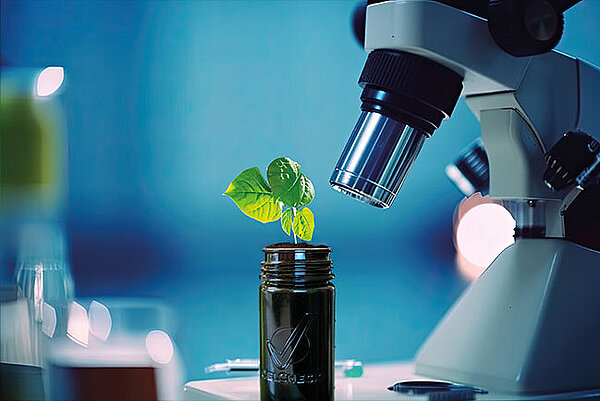OELCHECK lubricant analyses – their impact on sustainability and CO2 savings in industry
Publication year: 2023
Thanks to OELCHECK lubricant analyses, we only change the majority of our oils based on their condition. As a result, we have saved many tonnes of fresh oil over the years, drastically decreased the amount of used oil and significantly reduced the ecological footprint of our operations. We operate sustainably! But in the bigger picture, our company is just a small piece of the puzzle. What does it look like on a macroeconomic level? Do you know what quantities of lubricants have been saved in industry so far thanks to analyses? And what impact this has had on CO2 emissions?

Answering this question was a real challenge! Official figures are not available and, of course, we can only access our own data. However, the question has also interested us so much that we have delved deeper into the matter.
Pure waste
Since our company was founded in 1991, we have tested more than 5 million samples of used lubricants alone. For a large proportion of these samples, all of the values we examined were in the green range. In other words, the lubricants could actually continue to be used. However, we then carried out a check of the samples that customers had taken directly before an oil change based on their information. These customers had not waited for the laboratory results, but had already changed the oil prophylactically.
The results of our retrospective analysis were clear: For 25% of these samples, the values were all in the green range! The lubricants did not need to be changed!
With an average filling capacity (across all applications) of around 330 litres and an average oil service life of around 1,000 operating hours, around 120,000 tonnes of oil were changed too early and thus wasted.
In most of these cases, it is generally assumed that a 50% extension of the oil service life is realistic. However, even an extension of approx. 20% of the oil service life would have resulted in enormous savings in terms of costs and CO2
It’s time to rethink!
Changing high-performance lubricants early means wasting valuable resources and increasing CO2 emissions needlessly!
Lubricants play a crucial role in industry as they reduce friction and wear in machinery and equipment. They ensure trouble-free operation and extend the service life of the equipment. At the same time, however, lubricants are associated with CO2 emissions resulting from their manufacturing process, transport and disposal. Consequently, the aim must be to make the consumption of lubricants as efficient and long-lasting as possible.
Lubricant analytics is an ideal way to monitor the condition of lubricants in machines and the machines themselves, and to optimise operations. Regular analysis can identify potential problems such as oxidation, contamination and the wear of lubricated components early. Analytics enable targeted maintenance and determine the exact time to replace lubricants in order to ensure optimal performance. For this reason, many well-known equipment manufacturers link the oil service life to an accompanying oil analysis. For example, a major manufacturer of construction machinery permits a change interval of 2,000 operating hours if the machine is accompanied by oil analyses. Otherwise an oil change interval of 500 operating hours is specified.
However, another aspect of lubricant analysis must not be forgotten. The analytics also have a decisive influence on the reduction of CO2:
- Extended oil-change intervals: By monitoring the condition of the lubricant and replacing it in a targeted manner, the service life of the lubricants can be extended. This reduces the need for refills, any amounts of flushing oils and oil filters, and thus reduces the CO2 emissions associated with the production and disposal of lubricants.
- Reduced energy consumption: Efficient lubrication results in less friction loss in machinery. This enables energy savings and reduces the CO2 emissions associated with energy production.
- Prevention of unplanned downtime: By identifying problems early, lubricant analysis can reduce unplanned machine downtime and extend the lifetime of components and equipment. This also results in significant savings in terms of energy and CO2.
The positive influence of lubricant analysis on CO2 reduction is significant and varied. Some important aspects illustrate their contribution to this:
- Regular lubricant analyses and the targeted monitoring of the lubricant condition can reduce the need for refills. This leads to a reduction in CO2 emissions associated with the manufacturing, transportation and disposal of lubricants.
- Targeted maintenance based on the results of the lubricant analysis makes it possible to use the lubricant for longer without compromising the performance or operational safety of the machines. This reduces the need for regular lubricant changes, which in turn reduces CO2 emissions.
- Lubricant analysis enables problems such as wear, contamination or oxidation to be detected at an early stage. Correcting these problems in good time and using the right lubricants leads to improved machine efficiency. More efficient machines consume less energy, which leads to a reduction in CO2 emissions.
- Lubricant analysis enables proactive and preventive maintenance. By detecting problems early, maintenance can be planned and unplanned downtime is minimised. As a result, in addition to an unnecessary oil change, there is also no need to dispose of components, some of which would have also been replaced at fixed intervals. This not only increases productivity, but also reduces resource consumption and associated CO2 emissions.
- By implementing lubricant analyses for CO2 reduction, a company demonstrates its commitment to environmental protection and sustainability. This can improve the company’s image and contribute to stronger customer loyalty.
Conclusion:
Lubricant analysis is an effective instrument for CO2 reduction in industry. By optimising the consumption of lubricants, extending the usage intervals of lubricants, increasing machine efficiency and avoiding breakdowns, it makes a significant contribution to reducing CO2 emissions and, in doing so, supports companies on their way to a more sustainable future.
OELCHECKER Summer 2023, page 5




